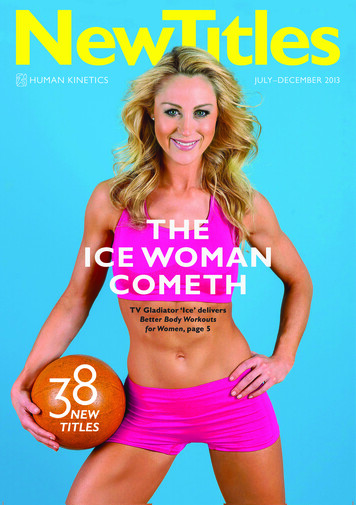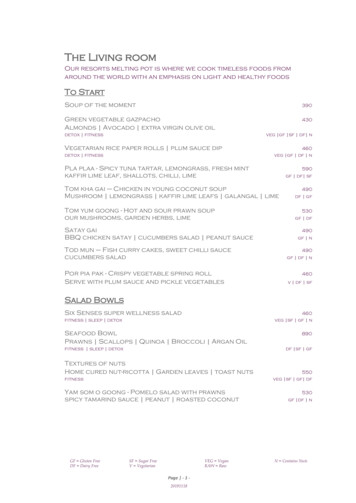
Transcription
HUMAN R 20132013THEICE WOMANCOMETHTV Gladiator ‘Ice’ deliversTV Gladiator ‘Ice’ deliversBetter Body WorkoutsBetterBody Workoutsfor Women,page 5for Women, page 538NEWNEWTITLESTITLES
Consumer20 BESTSELLERS1Strength Training Anatomy, 3rd EditionISBN 9 78 - 0 -7 3 6 0 -92 2 6 - 5AcademicHUMAN KINETICSNEW TITLES20 BESTSELLERS11 14.99 / 19.50Hatha Yoga IllustratedISBN 9 78-0-7360-6203-91 10.99 / 14.30Essentials of Strength Training &Conditioning, 3rd Edition11ISBN 9 78 - 0 -7 3 60 - 5 8 0 3 -2Exercise Psychology, 2nd EditionISBN 9 78 - 1 - 45 0 4 - 070 9 - 0 53.99 / 70.20 64.99 / 84.502Yoga Anatomy, 2nd EditionISBN 9 78 - 1 - 45 0 4 -0024- 412 14.99 / 19.50Delavier’s Stretching AnatomyISBN 9 78-1-4504-139 8-5 14.99 / 19.502Foundations of Sport & Exercise12Psychology, 5th EditionLow Back Disorders, 2nd EditionISBN 9 78 - 0 -7 3 60 - 669 2- 1 47.99 / 62.40ISBN 9 78 - 0 -7 3 60 - 8 323 -23The Art of Running FasterISBN 9 78 - 0 -7 3 6 0 -9550- 113 13.99 / 18.204Pilates AnatomyISBN 9 78 - 0 -7 3 6 0 -83 86 -714The Strength Training AnatomyWorkout, Volume II 58.99 / 76.70ISBN 9 78-0-7360-7959 -4 16.99 / 22.10 14.99 / 19.505Ultimate Skiing3ISBN 9 78 - 1 - 45 0 4 -3 432- 4 66.99 / 87.10ISBN 9 78 - 0 -7 3 60 -9 4 0 9 -2ISBN 9 78-0-7360-819 3-1 58.99 / 76.70ISBN 9 78 - 1 - 45 0 4 -1989- 5414NSCA's Essentials of Personal Training,Successful Coaching, 4th Edition2nd EditionISBN 9 78-0-7360-7571-8ISBN 9 78 - 0 -7 3 60 - 8 4 1 5 - 4 14.99 / 19.50 64.99 / 84.5016Breathe Strong, Perform Better15ISBN 9 78-0-7360-9 169 -55 13.99 / 18.20Postural Assessment17Anatomy WorkoutNEW Triathlon AnatomyISBN 9 78-1-4504-2138-66818Mastering Mountain Bike Skills,NEW Biomechanics of Sport and 13.99 / 18.20 16.99 / 22.10ISBN 9 78-1-4504-3278-89 13.99 / 18.2018Science and Practice of StrengthTraining, 2nd EditionISBN 9 78 - 0 -7 3 60 - 5 628 - 1ISBN 9 78 - 1 - 45 0 4 - 0 25 4 - 5 48.99 / 63.70 31.99 / 41.6020ISBN 9 78-1-4504-2020-49Delavier’s Core TrainingPeriodization, 5th Edition19Physical Activity Epidemiology,2nd EditionISBN 9 78 - 0 -7 3 60 -74 8 3 - 4ISBN 9 78 - 0 -7 3 60 - 8 28 6- 0 38.99 / 50.70 56.99 / 74.10ISBN 9 78 - 1 - 45 0 4 -1399-210 14.99 / 19.50Sport Nutrition, 2nd EditionISBN 9 78 - 0 -7 3 60 -79 62- 4 61.99 / 80.602ISBN 9 78 - 0 -7 3 60 -9 9 37- 0 24.99 / 32.50Statistics in Kinesiology, 4th EditionNEW Archery 16.99 / 22.10108Advanced Marathoning, 2nd EditionISBN 9 78 - 0 -7 3 6 0 -746 0- 5NEW Fitness & Health, 7th EditionISBN 9 78 - 0 -7 3 60 -79 66-2NEW The Healthy Heart Book 9.99 / 13.0017Exercise, 3rd Edition 64.99 / 84.5019Physiological Tests for Elite Athletes,2nd EditionISBN 9 78 - 0 -7 3 60 -9 7 1 1 - 6Men's Body Sculpting, 2nd Edition716 62.99 / 81.99 53.99 / 70.20ISBN 9 78-0-7360-8321-8 47.99 / 62.40ISBN 9 78 - 1 - 45 0 4 -21 0 4 - 1 14.99 / 19.502nd EditionISBN 9 78 - 0 -7 3 6 0 -8371-3Muscle ImbalanceSport FinanceISBN 9 78 - 1 - 45 0 4 -0095- 4 16.99 / 22.10Assessment and Treatment ofISBN 9 78 - 1 - 45 0 4 - 0 0 9 6- 1 21.99 / 28.60 33.99 / 44.207ISBN 9 78 - 0 -7 3 60 - 8 260 - 0ISBN 9 78 - 0 -7 3 60 -74 0 0 - 1ISBN 9 78 - 1 - 45 0 4 -0051- 0The Strength TrainingSports Massage 22.99 / 29.90 16.99 / 22.1064th Edition5th EditionDance AnatomySwimming AnatomyNEW Introduction to Kinesiology,Physiology of Sport & Exercise, 16.99 / 22.101513Tel. 0113 255 5665Fax. 0113 255 5885hk@hkeurope.comhumankinetics.com20101 Classroom GamesISBN 9 78 - 0 -7 3 60 -951 0 - 5 12.99 / 16.903
ConsumerHUMAN KINETICSDue Nov 2013174 colour illustrations160 colour photographs179 x 254 mm224 ppPaperback 14.99 / 19.50Part of the bestsellingAnatomy series, see themall at humankinetics.comBodyweight Strength training dominisRectusabdominisfcclFigure 5.1 Rectus abdominis, transversusabdominis, internal and external obliques.This is a sample credit line. Reprinted from Roetert, E.P., andKovacs, M.S., 2011, Tennis Anatomy, Human Kinetics, page 14.The Bodyweight Challengespine by providing intra-abdominalpressure. These inner core musclesconsist primarily of the multifidus inthe rear, the transversus abdominisin the front and on the sides, thediaphragm up top, and the pelvicfloor muscles on the bottom (figures5.3 and 5.4).Dynamic core exercises—coreexercises that involve movementsuch as spinal flexion, extension,lateral flexion, and rotation—arebetter suited for targeting individualmuscles and teaching the core toproduce and reduce force. Corestability exercises—core exercisesthat keep the spine in a static, orisometric, position—are better suitedfor teaching the body to resist movement and engage the inner core unit.Both types of exercises are important for optimal core function andperformance.E5716/Contreras/Fig oas majorLongissimusPsoas adratuslumborumGluteusmediusabFigure 5.2 Core muscles on the (a) back and(b) front of the mCoccygeusLevatorani Figure 5.4 Pelvic floor hragmFigure 1Core exerCisesThis chapter contains a variety of core exercises that will improve your ability toproduce motion through concentric power, resist motion through isometric power,and absorb or decelerate motion through eccentric power. Each of these qualities is important in sports and functional movement. Not only does the chaptercontain a balance of dynamic and static, or isometric, exercises, it also variesexercises in terms of planes and directions of movement. For example, frontalplane exercises are well suited for transferring to lateral movement, sagittal planeexercises are well suited for transferring to forward and backward movement, andtransverse plane exercises are well suited for transferring to rotary movement.Finally, the chapter contains a balance of beginner and advanced exercises toaccommodate a wide range of ability and to allow for the development of power,strength, and strength endurance in addition to well-developed abs.You must understand correct exercise technique for the different areas of yourcore. Your hips and thoracic spine (upper back) should be mobile and moveefficiently; however, you should limit spinal motion in the lumbar region. Forexample, when performing crunches and side crunches, your upper back shouldmove the most while the lower back, or lumbar spine, moves the least. It is alsoessential to maintain good posture during core-stability exercises. Proper bodyposition while you’re building isometric strength and endurance will transfer tothe field, so be aware of what your body looks like when holding core-stabilityexercises.E5716/Contreras/Fig. 5.2a/446093/JenG/R111BODYWEIGHT STRENGTHTRAINING ANATOMYBret ContrerasISBN 9 78-1-4504 -3 8 1 5 - 5In Bodyweight Strength Training Anatomy,author and renowned trainer Bret Contrerashas created the authoritative resource forincreasing total-body strength without theneed for free weights, fitness machines, oreven a gym.Going far beyond standard pull-ups, pushups and squats, Bodyweight Strength TrainingAnatomy presents 156 innovative exercises thatwork every muscle in the body.Each exercise includes step-by-step instructions demonstrating proper technique, andmore than 170 full-colour anatomical illustrations depict muscles in action and point outwhich ones are being engaged.Part of Human Kinetics’ bestsellingAnatomy series that has sold more than twomillion copies.224 ppDue Dec 2013ISBN 9 78 -1-45 0 4 - 6 3 59 - 1120 colour illustrations237 colour photographs179 x 254 mm144 ppPaperback 16.99 / 22.10Part of the bestsellingAnatomy series, see themall at humankinetics.comSTRETCHING ANATOMY,2nd EditionArnold G. Nelson and Jouko Kokkonen118 colour illustrations119 colour photographs179 x 254 mmPaperback 14.99 / 19.50Part of the bestsellingAnatomy series, see themall at humankinetics.comAnterior deltoidSubclaviusPectoralis majorCoracobrachialisPectoralis minorBiceps brachiiLatissimus dorsiVisually stunning and immediately accessible, this bestselling guide has step-by-stepinstructions for 86 stretches and 110 colouranatomical illustrations highlighting all themuscles engaged.More than an instruction manual, Stretching Anatomy shows the procedure and utilityfor each exercise as well as safety considerations, benefits and variations for increasing ordecreasing difficulty.Stretching provides numerous benefits,including improved flexibility, stamina, postureand muscular strength as well as reduced muscle soreness.Stretching Anatomy is one of 20 titles in theAnatomy series, Human Kinetics’ bestsellingseries of all time with over two million copiesin print.Due Dec 2013DELAVIER'S MIXED MARTIALARTS ANATOMYFrédéric Delavier and Michael GundillISBN 9 78-1-4504 -3276- 4For more than a decade, Frédéric Delavier’sacclaimed books have enjoyed robust sales,including his bestselling Strength TrainingAnatomy, which has sold more than 1.5 millioncopies worldwide.Now the acclaimed author, illustrator andformer powerlifting champion brings his expertise to the immensely popular sport of mixedmartial arts.Featuring the most effective exercises forenhancing the full range of combat skills, thisinvaluable resource allows athletes to spendless time in the gym and more time in the ring.This distinctive approach will help themenhance their strengths while improving theirweak points.264 ppDelavier's signature illustrations will floor readers.4NEW TITLESDue Dec 2013ISBN 9 78 -1-45 0 4 -29 29 - 010Consumer1 colour 240 colour photographs179 x 254 mmBETTER BODY WORKOUTSFOR WOMENDean Hodgkin and Caroline PearceIn Better Body Workouts for Women, fitnessexpert Dean Hodgkin and TV star, CarolinePearce present a training system tailored to theunique needs and goals of women.The book offers routines that can beperformed both at home and in the gym andis packed with full-colour photographs ofworkouts for fat loss, strength, endurance,agility and power.Readers will also be able to assess their fitness levels and develop personalized routinesthat accommodate recent injuries, pregnancy,menopause and osteoporosis.Users are able to track their progress with atraining log and balance workouts with a nutrition programme that explains how to eat well,set goals and overcome barriers.Paperback 13.99 / 18.20Cover subject to changeTV Gladiator and Channel 5 presenter Caroline Pearce.Tel. 0113 255 5665Fax. 0113 255 5885hk@hkeurope.comhumankinetics.com5
ConsumerHUMAN KINETICSDue Dec 2013371 photographs216 x 279 mm232 ppPaperback 13.99 / 18.20Goal-Setting, Assessing Fitness, and Training SafelyKettlebell Training b How KettlebellsDiffer From DumbbellsFrequency describes how often you exercise.It can be denoted in how many days per weekor days per month you spend on your kettlebell training routine. Frequency can reflectthe number of kettlebell workouts per week ormonth, the number of exercises per kettlebellworkout, the number of sets per exercise and/orthe number of repetitions per set. For example ifyou exercise once each day for 4 days per week,your frequency is 4 workouts per week. If youexercise twice per day for 3 days per week, yourfrequency is 6 times per week.In order to maintain a healthy body and tobecome fitter, a general recommendation is foryou to exercise at least 4 days out of the week.Keep in mind that there is an inverse relationship between frequency and intensity, whichis the I in F.I.T.T. Collectively, frequency andintensity will equal the total volume of exercise,which is the total amount of exercise performedper unit of time (day, week, month, etc.). Themore frequently you exercise, the less intensethe workouts can be. Conversely, the moreintense the workouts are, the less frequently youcan exercise. This has to do with the effect oftotal volume of exercise on your body’s abilityto recover, which is the subject of this chapter’ssidebar. c Plate-Loaded Adjustable KettlebellsThere are three types of plate-loaded adjustablekettlebells. One is not really a kettlebell at all,but is still classified as such. This is a handlewhich you attach to weight plates with screwsand bolts (see figure 1.1a). One brand of kettlebell handle is called the Kettlestack. The othertype of plate-loaded kettlebell is made from ahard plastic and has a casing which screws apart(see figure 1.1b). When you open this kind ofadjustable kettlebell there are several “slices”or pieces of plastic. Some are hollow and someare solid. Depending upon how many hollow orsolid pieces you insert, you can vary the weightof the kettlebell, typically ranging from 16kg(35lb) at lightest up to 32kg (70lb) at heaviest.There are also smaller versions that use lighterweight ranges. Once you select the combination of pieces to make the desired weight, youscrew the handle and ball together with a boltand screw that runs from the base all the waythrough the body of the kettlebell. Another kindof adjustable kettlebell combines the plates withthe solid outer casing (see figure 1.1c). This ismade of steel and you screw the handle awayfrom the ball. Inside is a rod that you can stackweight plates onto. More weight plates will makea heavier kettlebell and less weight plates willmake a lighter kettlebell.The main advantage of adjustable kettlebellsis you end up having to buy fewer kettlebellsso they are less expensive. Another advantageis that 1 or 2 adjustable kettlebells take up lessspace in your training area as compared to havedifferent kettlebells for each weight you wantto train with. The drawback with adjustablekettlebells is that they are not of the standarddimensions for Kettlebell Sport, so they cannotbe used for competition training.CostThese are not so common but one time in theearly part of the 20th Century, shot-loaded kettlebells were more common. Typically, they wouldbe metal with a hole and a plug on one side orthe bottom (see figure 1.2). They might be filledwith sand, water, lead or even mercury! Mercuryis a very heavy metal and was used in order fitmore density (weight) into a fixed-sized kettlebell. These were the kind of kettlebells used inCircus Strongman performances such as thefamous Strongmen Arthur Saxon and EugeneSandow. Advantages of this type of adjustablekettlebell is that the user still gets the feel ofreal steel in the hands, but is able to do so withonly one or two kettlebells since the load canbe adjusted. Disadvantage is inconvenience ofhaving to change the load as well as the messand labor involved in adding or subtractingmaterials into or out of the kettlebells. Also, itis not easy to find heavy metals and mercury isa highly toxic substance for those who want toFPO fc Figure 1.1 Plate-loaded adjustable kettlebells: Adjustable plate loadable (a),Adjustable shot loadable (b), and Adjustable kettlebell handle (c).use of super-duper heavier than heck kettlebells.One additional feature that is unique toshot-loaded adjustable kettlebells is that if thekettlebell is not completely filled, the shot insidewill shift around during various movement ofthe kettlebells, giving an added training effectas the body has to adjust to the shifting loads.An inexpensive form of steel shot is bbs thatcan be found in many sporting goods stores thatcarry hunting equipment. This is an interestingfeature but in the authors opinion not significantenough to overshadow the benefits and convenience of modern fixed-load kettlebells.resistance intensity. One simple way for you tomeasure the intensity of your workout routineis to wear a heart rate monitor, which will measure intensity as a function of your heart rate.This method of determining intensity relates tothe cardiorespiratory component of kettlebellIntensityIntensity refers to how vigorously you performyour kettlebell exercises. Intensity can alsodescribe the amount of energy or effort neededto execute a particular exercise or exercise session. The intensity of exercise can be expressedin several different ways.Kettlebell lifting combines cardiorespiratorytraining with resistance training. The intensityof your kettlebell workout can be measuredas a function of cardiovascular intensity orFPOFigure 1.2Shot-loaded adjustable kettlebell.3KETTLEBELL TRAININGSteve CotterISBN 9 78-1-4504 - 59 9 3 - 8In recent years the all-in-one handheld gymhas taken the fitness world by storm. In 2011,nearly 47 million Americans used some formof hand weights and the popularity of kettlebells continues to rise thanks to the way theyhelp improve strength, endurance, coordination and balance.Few people are more knowledgeable aboutthe benefits of kettlebell use than Steve Cotter. A leading kettlebell expert, martial artistand certified strength and conditioning specialist, Cotter has trained professional AmericanFootball teams, Navy SEALs and US Marines.Offering extensive coverage on gettingstarted – including setting goals, assessingfitness and using safe technique – this guidefeatures step-by-step instructions with photosequences depicting key movements.152 x 229 mmISBN 9 78 -1-45 0 4 - 19 69 -729 colour illustrations467 colour photographs216 x 279 mm336 ppPaperback 14.99 / 19.50NANCY CLARK'SSPORTS NUTRITIONGUIDEBOOK, 5th EditionNancy Clark30 illustrations1 photograph544 ppPaperbackWith over 550,000 copies sold, Nancy Clark’sSports Nutrition Guidebook is the number onenutrition resource for active people.Nancy Clark is an internationally respectedsports nutritionist and registered dietitian whospecializes in nutrition for exercise and health.She is also experienced in the nutritional management of eating disorders.This latest edition provides comprehensivecoverage for athletes and fitness exercisersalike. It contains updated information on thenutrition needs of both sexes in several sportsand also includes new information on supplements, energy drinks, and nutrient timing aswell as advice for athletes who have undergone gastric bypass surgery. 13.99 / 18.20Due Oct 2013Due Oct 2013CONDITIONING TO THE COREGreg Brittenham and Daniel TaylorISBN 9 78-0-7360 -951 1 -2The primary goal for this book is to deliver atorso trained for high-level sport performance.The book offers a functional approach tocore training for athletes seeking a competitiveedge in sports. Colour-coded stability, strengthand power training exercises and programmeshelp readers grasp the proper design of aregime able to meet their respective goals.Full-colour anatomical artwork and demonstration photos further inform readers ondeveloping the most functional athletic core.Conditioning to the Core includes the mosteffective assessment tools and proven trainingprogrammes, complete with sport-specificexamples, tips and applications for football,basketball, swimming, running and more.179 x 254 mmTel. 0113 255 5665hk@hkeurope.comFull-colour functional training for the core6NEW TITLESDue Dec 2013ISBN 9 78 -1-45 0 4 -3 0 1 1 - 12ConsumerFax. 0113 255 5885CAFFEINE FOR SPORTSPERFORMANCELouise Burke, Ben Desbrowand Lawrence Spriet12 illustrations3 photographs216 ppPaperback 12.99 / 16.90Ch apt8BerRecovery andConside Otherrationsack in the goodold dagameLife was or race. Get to ys, athletes justthe startsimused toing lineworry abThe mod ple.or starting siren out the day ofapproach ern world of. Go hathesprd. Goperiodi to managing pe ort science, hohome.zed traiwrfoevrmer,ning anance gohas a fasessions.d thals.rmWawarded e also realize e importance We now recogn ore sophisticatofthedafize theto think ter a series of at the gold med recovery andbenefitsadofgames orfrom daal or chRecoveryampion aptation betweeship troy is now to day and join heats and finals. Inphy is of nan induthe dotsWith thottehestrnberwords,tween wconsider at in mind, th y.weorkoutsere arein relatioor compe needsome adcategoryntition.diof recove to caffeine anperformd perfo tional issues thry, but thrmanceance.atey mayathl. We wetes needalso floillhumankinetics.comCaffeine for Sports Performance is the definitiveresource on caffeine and its use and impact onsports performance. Based on the most recentresearch, studies and guidelines, this guide isideal for athletes and fitness enthusiasts looking to improve training and competition.Caffeine for Sports Performance providesplenty of practical tips for using caffeine as anaid to improved physical performance. Readers will also find interviews with top athletesand coaches regarding their experiences usingcaffeine particularly interesting.It provides new insight into currentattitudes towards caffeine and how those attitudes have changed over the years.7
ConsumerHUMAN KINETICSDue Dec 2013ISBN 9 78 -1-45 0 4 -32 1 5 -35 illustrations18 photographs179 x 254 mm392 ppHardback 16.99 / 22.1010 photographs178 x 254 mm376 ppPaperback 13.99 / 18.20NEW TITLESDue Dec 2013ENDURANCE SPORTSNUTRITION, 3rd EditionSuzanne Girard EberleISBN 9 78-1-4504 -3 4 1 7- 1Packed with nutrition plans for middle andlong-distance, ultra-endurance and multidayevents, Endurance Sports Nutrition focuseson the unique nutritional needs of enduranceathletes, including runners, cyclists, mountainbikers, open-water swimmers and triathletes.This comprehensive resource providesin-depth strategies for day-to-day consumption including dining away from home, eatingvegetarian and managing food intolerances.256 ppYOGA FOR RUNNERSChristine Felstead18 illustrations369 photographs179 x 254 mmChristine Felstead’s unique program, Yogafor Runners, provides a proven cross-trainingapproach to the sport. Practical and accessible,this guide shows runners how to incorporateyoga into their routine to improve breathing,strength, flexibility, endurance, mental sharpness and overall athletic performance.Paperback 13.99 / 18.20Due Sept 2013ISBN 9 78-0-7360 -74 1 8 - 6RUNNING SCIENCEOwen Anderson10 illustrations151 photographs178 x 254 mmDue Oct 2013ISBN 9 78 -1-45 0 4 -3 0 1 7-3ConsumerPOWER EATING, 4th EditionSusan Kleiner and MaggieGreenwood-RobinsonThis fourth edition of Power Eating offers readers a better way to achieve goals in physiqueand performance, in ways that are safe, legaland effective.It provides the latest scientifically provennutrition guidance, popular diet plans that provide meal suggestions for each meal of the dayand new findings suggesting how certain plantscan improve performance when introduced toyour diet.Running Science is an easy to understandrepository of running research and offers awealth of insights distilled from great sport andexercise scientists, coaches and runners.It provides an array of the most credible and widely used training principles andprogrammes.608 ppPaperback 18.99 / 24.70ALSO AVAILABLETriathlon Science, ISBN:9 78-0-1430-4238 0 -9Due Nov 2013ISBN 9 78-1-4504 - 4 0 19 - 6COACHING CROSS COUNTRYSUCCESSFULLY, 2nd EditionPat Tyson and Doug Binder6 illustrations117 photographs216 x 279 mm168 ppPaperback 14.99 / 19.50Due Aug 2013ISBN 9 78 -0 -73 6 0 -9 3 69 -91 illustration2 photographs178 x 254 mm304 ppPaperback 12.99 / 16.908THE ATHLETE'S GUIDE TOSPORTS SUPPLEMENTSKimberly Mueller and Josh Hingst140Coaching Cross Country SuccessfullyEvaluating Runners’ Performance 141Figure 12.1 Postmeet evaluation Sheetgreater SPokane dual comPetitionUniversity High School’s Home Course, Liberty LakeA countless number of new, renamed and variations of sport supplements flood the marketeach year. This book separates fact fromfiction, provides quick answers to the mostcommon questions and delivers trustworthyinformation. It provides concise descriptionsfor 120 of today’s most popular supplementsand details, how it works, performance benefits, research studies and outcomes, dosagerecommendations and health concerns.Tel. 0113 255 5665Fax. 0113 255 5885As the headlines said in this morning’s Spokesman-Review: Panthers serve notice. “The hunter hasbecome the hunted, thanks in part to Mead sophomore Jesse Fayant, who was part of a gritty fourrunner effort. In a season-opening Greater Spokane League cross country meet befitting the state’s topthree teams, Fayant’s sprint to third place helped the Panthers to a 27-29 victory over the defendingchampion and top-rated University Titans. Caught in the crossfire was Mt. Spokane, which lost 27-29to the Titans and 22-33 to Mead.”*What a great stuff guys! Note feedback:Chris Fayant (15:51) 2nd Place. Only 6 seconds off winning! Nice effort for the team. You gaveUniversity’s No. 1 runner, Max Schmidt, (15:45) all he could handle on his tough home course. Iknow you are on fire, Chris!Jesse Fayant (16:10) 3rd Place. You edged the No. 2 University runner, Brandon Stum, in asame-time photo finish! Just think, Jesse, if you get beat, our team gets beat with a reverse score.You ran incredibly tough on the second hill, and you really were brave coming up that last 40-meterhill to the finish chute. Nice job. Some day you will be a state champion. You are only a sophomore.Kelly Compogno (16:24) 5th place. You beat University’s No. 3 runner by 28 seconds! Greatpacing and focus. You told me you were going to have no mental lapses during the run. It wasevident that you didn’t.Nate Boyer (16:40) 6th place. You ran like a veteran over this tough three-mile (1.5 2 loops)Liberty Lake course! Finishing 12 seconds ahead of University’s No. 3 runner was huge. You showedthe value of depth up front.athletes, these adjustments could becomean ongoing process. And it’s exciting whenyoung runners are exploring their potentialand finding that they have more that theycan give.Another way to evaluate results is to examine the amount of time between your No. 1runner and your No. 7. This is the spread.A top seven that finishes within 60 secondsof one another creates an A group for training. Many of them may even share the samedate pace and goal pace, which is beneficialbecause they can go through the same workout together. They can feed off each other.As an example, you might have a workoutthat is seven 1,000 meters, and the datepace is 16:00, so each interval would be doneat 3:12. Or you could alternate them withgoal pace (3:08 per 1,000 equates to a 15:40target). Each member of the top seven couldlead an interval, beginning with the seventhman and finishing with the first. This sort ofworkout creates a great team feeling and alsoteaches pace.If one or more runner in the group is running out of gas—either in the last mile ofa race or in workouts—you can adjust theworkout. You might start the workout withfour or five 1,000-meter intervals at datepace, then go up to goal pace for the sixth,and ask the runners to dig deep for the last1,000 (sub-3:00). The recovery time is upto you, usually five to six minutes for eachinterval. Always make sure athletes get a fullrecovery.Error on the side of more recovery thanless. As you gain experience, you will beginto gauge appropriate recovery from bodylanguage, but heart rate is a good indicatoras well. One thing that I recommend athleteskeep in their journal is their resting heartbeat. They should check it every morning when they wake up. If it is abnormallyhigh (like 10 beats or more above normal)it could be a sign of not enough recovery.Resting heart beats vary. Many top runnershave a resting heart rate of about 50 beatsper second. (Steve Prefontaine’s was about40.) In the midst of interval training, recoverwith a light jog. When the heart rate is backto 90-110, it’s generally safe to start the nextinterval.Patrick Chessar (17:09) 11th place. You are our No. 5 runner and thus count in our team score.You were only 17 seconds behind University’s No. 3 runner, 13 seconds behind their No. 4, and12 seconds behind their No. 5! We’ll need you closer as the season progresses. You can run withBoyer. Pack up and feed off of him. You help Nate, and Nate helps you, and this helps the team.Keep believing.Tim Schuermer (17:15) 12th place. You are our No. 6 runner. You ran really well for a youngsophomore. You will get stronger. Don’t be afraid to go out a bit harder with Nate Boyer. We needto pack up more. It will come. Nice closure over the last 400 meters!Bryan Becherini (17:16) 13th place. You beat University’s no. 7 runner by 25 seconds and wererunning in a nice pack with your buddies Schuermer and Chessar. You, too, are only a sophomore.I am excited to see how you progress throughout the season. Keep believing and knowing you willhelp our team shock people like we did today!*Mike Vlahovich. September 23,1999. “Panthers Serve Notice.” Spokesman Review.results to realign goal paces and establishnew date paces. For example, if an athletehad a preseason goal of running 16:00for 5,000 meters (77-second pace per 400meters) and achieved that in the middle ofthe season, it would be time to come up witha new goal. A reasonable adjustment wouldbe a goal of 15:40, which would be 5:02-milepace or 75-second 400 meters pace. Thatathlete would have a date pace of 77 secondsand would aim for 75 seconds when doinggoal-paced intervals. For rapidly improvinghk@hkeurope.comCaption to come.humankinetics.comCoaching Cross Country Successfully coversevery aspect of how to build and maintain asuccessful cross country programme. Offering advice for coaches from primary school touniversity levels, the book explores the mostimportant aspects of coaching a successfulcross country team.The book goes beyond the physical aspectsof running to describe other factors related toperformance, such as motivating runners andgetting athletes hooked on running, so that theteam stays enthused about running every day.Coaching Cross Country Successfully covers areas that coaches need but often fail toconsider, such as recruiting students to theprogramme; working with coaching staff,school administrators, parents and volunteers;fund-raising; and hosting meetings.9
ConsumerHUMAN KINETICSDue July 2013ISBN 9 78 -1-45 0 4 -29 3 0 - 61
18 Men's Body Sculpting, 2nd Edition ISBN 978-0-7360-8321-8 13.99 / 18.20 19 NEW The Healthy Heart Book ISBN 978-1-4504-3278-8 9.99 / 13.00 20 NEW Archery ISBN 978-1-4504-2020-4 16.99 / 22.10 20 BESTSELLERS 20 BESTSELLERS ACAdEMIC NEW TITLES hkhkeurope.com humankinetics.com 3 CONsuM










